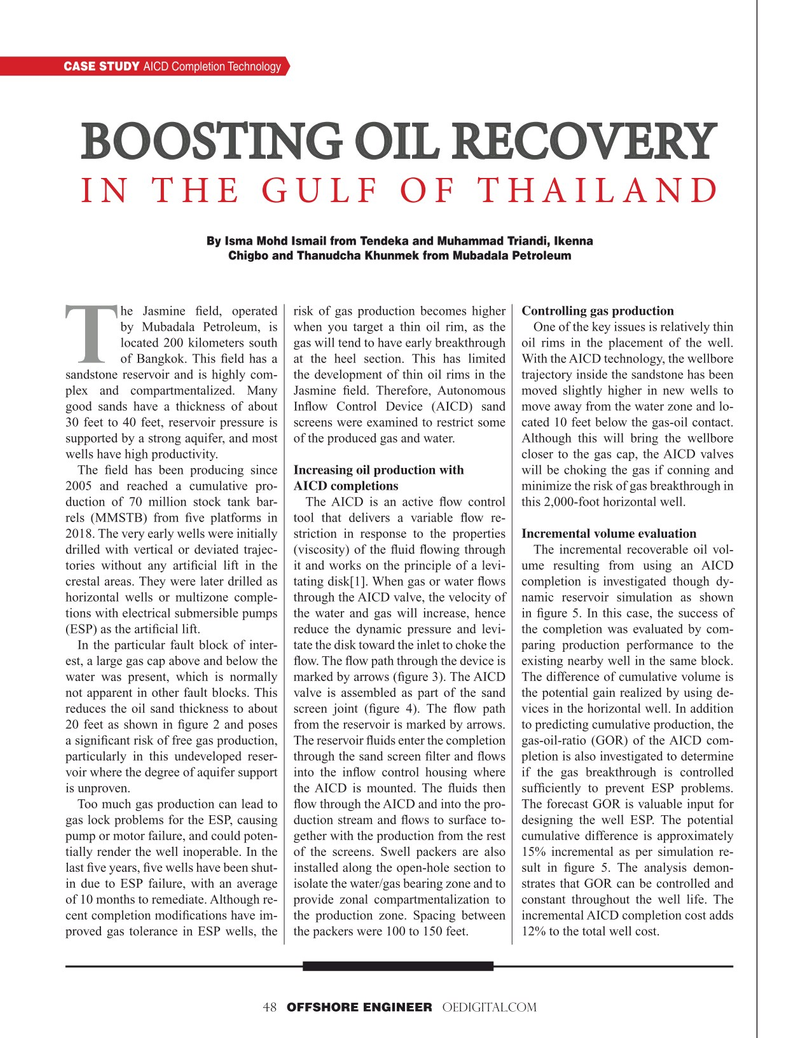
Page 48: of Offshore Engineer Magazine (Mar/Apr 2019)
Deepwater: The Big New Horizon
Read this page in Pdf, Flash or Html5 edition of Mar/Apr 2019 Offshore Engineer Magazine
CASE STUDY AICD Completion Technology
BOOSTING OIL RECOVERY BOOSTING OIL RECOVERY
IN THE GULF OF THAILAND
By Isma Mohd Ismail from Tendeka and Muhammad Triandi, Ikenna
Chigbo and Thanudcha Khunmek from Mubadala Petroleum he Jasmine ? eld, operated risk of gas production becomes higher Controlling gas production by Mubadala Petroleum, is when you target a thin oil rim, as the One of the key issues is relatively thin located 200 kilometers south gas will tend to have early breakthrough oil rims in the placement of the well.
T of Bangkok. This ? eld has a at the heel section. This has limited With the AICD technology, the wellbore sandstone reservoir and is highly com- the development of thin oil rims in the trajectory inside the sandstone has been plex and compartmentalized. Many Jasmine ? eld. Therefore, Autonomous moved slightly higher in new wells to good sands have a thickness of about In? ow Control Device (AICD) sand move away from the water zone and lo- 30 feet to 40 feet, reservoir pressure is screens were examined to restrict some cated 10 feet below the gas-oil contact. supported by a strong aquifer, and most of the produced gas and water. Although this will bring the wellbore wells have high productivity. closer to the gas cap, the AICD valves
The ? eld has been producing since Increasing oil production with will be choking the gas if conning and 2005 and reached a cumulative pro- AICD completions minimize the risk of gas breakthrough in duction of 70 million stock tank bar- The AICD is an active ? ow control this 2,000-foot horizontal well. rels (MMSTB) from ? ve platforms in tool that delivers a variable ? ow re- 2018. The very early wells were initially striction in response to the properties Incremental volume evaluation drilled with vertical or deviated trajec- (viscosity) of the ? uid ? owing through The incremental recoverable oil vol- tories without any arti? cial lift in the it and works on the principle of a levi- ume resulting from using an AICD crestal areas. They were later drilled as tating disk[1]. When gas or water ? ows completion is investigated though dy- horizontal wells or multizone comple- through the AICD valve, the velocity of namic reservoir simulation as shown tions with electrical submersible pumps the water and gas will increase, hence in ? gure 5. In this case, the success of (ESP) as the arti? cial lift. reduce the dynamic pressure and levi- the completion was evaluated by com-
In the particular fault block of inter- tate the disk toward the inlet to choke the paring production performance to the est, a large gas cap above and below the ? ow. The ? ow path through the device is existing nearby well in the same block. water was present, which is normally marked by arrows (? gure 3). The AICD The difference of cumulative volume is not apparent in other fault blocks. This valve is assembled as part of the sand the potential gain realized by using de- reduces the oil sand thickness to about screen joint (? gure 4). The ? ow path vices in the horizontal well. In addition 20 feet as shown in ? gure 2 and poses from the reservoir is marked by arrows. to predicting cumulative production, the a signi? cant risk of free gas production, The reservoir ? uids enter the completion gas-oil-ratio (GOR) of the AICD com- particularly in this undeveloped reser- through the sand screen ? lter and ? ows pletion is also investigated to determine voir where the degree of aquifer support into the in? ow control housing where if the gas breakthrough is controlled is unproven. the AICD is mounted. The ? uids then suf? ciently to prevent ESP problems.
Too much gas production can lead to ? ow through the AICD and into the pro- The forecast GOR is valuable input for gas lock problems for the ESP, causing duction stream and ? ows to surface to- designing the well ESP. The potential pump or motor failure, and could poten- gether with the production from the rest cumulative difference is approximately tially render the well inoperable. In the of the screens. Swell packers are also 15% incremental as per simulation re- last ? ve years, ? ve wells have been shut- installed along the open-hole section to sult in ? gure 5. The analysis demon- in due to ESP failure, with an average isolate the water/gas bearing zone and to strates that GOR can be controlled and of 10 months to remediate. Although re- provide zonal compartmentalization to constant throughout the well life. The cent completion modi? cations have im- the production zone. Spacing between incremental AICD completion cost adds proved gas tolerance in ESP wells, the the packers were 100 to 150 feet. 12% to the total well cost.
48 OFFSHORE ENGINEER OEDIGITAL.COM 32-49 OE 2019.indd 48 4/15/2019 11:01:01 AM

 47
47

 49
49